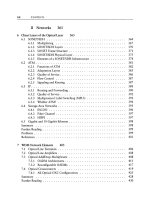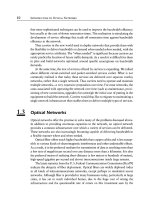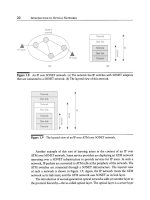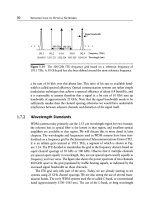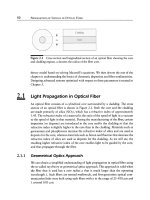Optical networks a practical perspective 3rd edition
Bạn đang xem bản rút gọn của tài liệu. Xem và tải ngay bản đầy đủ của tài liệu tại đây (4.98 MB, 928 trang )
The horizons of optical networks are much more than high speed physical layer transport. An intelligent optical network design
must include higher network layer considerations. This is the only book currently on the market that addresses optical networks
from the physical layer to the network layer and should be valuable for those who try to understand the intricacies of what
optical networks can be.
—Vincent Chan, Professor, MIT Department of Electrical Engineering and Computer Science
This book is not only essential reading for anyone in the optical networks industry, it is important. It provides the necessary
foundation of learning for anyone hoping to contribute to this technology’s rapid evolution.
—Scott Clavenna, President, PointEast Research
The authors’ grasp of what is truly workable and worthwhile in optical networks is fundamental, and they have effectively
packaged this knowledge in an easy-to-comprehend text that will be valued to both veterans and those new to optical
networking.
—Scott Grout, President and CEO, Chorum Technologies
This is a comprehensive and authoritative work on optical networks, ranging in scope from components and systems to overall
design principles. I find the book well organized and easy to use, and I particularly like the treatment of network design and
operation. An essential book for anyone seriously interested in optical networks.
—Goff Hill, Chief Network Architect, Altamar Networks, UK
I really enjoy the bottoms-up approach taken by the authors to address fundamentals of optical components as the enablers,
optical transmission system design and engineering as the building blocks, and network architecture and its management
features that deliver applications to the network operators and services providers at the top of the food chain.
—Shoa-Kai Liu, Director of Advanced Technology, Worldcom
This book not only provides the fundamentals and details of photonics, but the pragmatic perspective presented enables
the service provider, the equipment manufacturer, and the academician to view light from a real-life standpoint.
—Mathew Oommen, Vice President, Network Architecture, Williams Communications Group
This book functions as both an introduction to optical networking and as a text to reference again and again. Great for system
designers as well as those marketing and selling those systems. Optical Networks provides theory and applications. While no
text can be truly state-of-the-art in the fast moving area of optical networking, this one comes as close as possible.
—Alan Repech, System Architect, Cisco Systems Optical Transport
This book provides the most comprehensive coverage of both the theory and practice of optical networking. Its up-
to-date coverage makes it an invaluable reference for both practitioners and researchers.
—Suresh Subramaniam, Assistant Professor, Department of Electrical and Computer Engineering, George Washington
University
This book provides an excellent overview of the complex field of optical networking. I especially like how it ties the optical
hardware functionality into the overall networking picture. Everybody who wants to be a player in the optical networking space
should have this book within easy reach.
—Martin Zirngibl, Director, Photonics Network Research, Lucent Technologies, Bell Laboratories
The Morgan Kaufmann Series in Networking
Series Editor, David Clark, M.I.T.
P2P Networking and Applications
John Buford, Heather Yu, and Eng Lua
The Illustrated Network
Walter Goralski
Broadband Cable Access Networks: The HFC Plant
David Large and James Farmer
Technical, Commercial and Regulatory Challenges of QoS: An Internet Service Model
Perspective
XiPeng Xiao
MPLS: Next Steps
Bruce S. Davie and Adrian Farrel
Wireless Networking
Anurag Kumar, D. Manjunath, and Joy Kuri
Internet Multimedia Communications Using SIP
Rogelio Martinez Perea
Information Assurance: Dependability and Security in Networked Systems
Yi Qian, James Joshi, David Tipper, and Prashant Krishnamurthy
Network Analysis, Architecture, and Design, 3e
James D. McCabe
Wireless Communications & Networking: An Introduction
Vijay K. Garg
IPv6 Advanced Protocols Implementation
Qing Li, Tatuya Jinmei, and Keiichi Shima
Computer Networks: A Systems Approach, 4e
Larry L. Peterson and Bruce S. Davie
Network Routing: Algorithms, Protocols, and Architectures
Deepankar Medhi and Karthikeyan Ramaswami
Deploying IP and MPLS QoS for Multiservice Networks: Theory and Practice
John Evans and Clarence Filsfils
Traffic Engineering and QoS Optimization of Integrated Voice & Data Networks
Gerald R. Ash
IPv6 Core Protocols Implementation
Qing Li, Tatuya Jinmei, and Keiichi Shima
Smart Phone and Next-Generation Mobile Computing
Pei Zheng and Lionel Ni
GMPLS: Architecture and Applications
Adrian Farrel and Igor Bryskin
Content Networking: Architecture, Protocols, and Practice
Markus Hofmann and Leland R. Beaumont
Network Algorithmics: An Interdisciplinary Approach to Designing Fast Networked Devices
George Varghese
Network Recovery: Protection and Restoration of Optical, SONET-SDH, IP, and MPLS
Jean Philippe Vasseur, Mario Pickavet, and Piet Demeester
Routing, Flow, and Capacity Design in Communication and Computer Networks
Michał Pióro and Deepankar Medhi
Wireless Sensor Networks: An Information Processing Approach
Feng Zhao and Leonidas Guibas
Communication Networking: An Analytical Approach
Anurag Kumar, D. Manjunath, and Joy Kuri
The Internet and Its Protocols: A Comparative Approach
Adrian Farrel
Modern Cable Television Technology: Video, Voice, and Data Communications, 2e
Walter Ciciora, James Farmer, David Large, and Michael Adams
Policy-Based Network Management: Solutions for the Next Generation
John Strassner
MPLS Network Management: MIBs, Tools, and Techniques
Thomas D. Nadeau
Developing IP-Based Services: Solutions for Service Providers and Vendors
Monique Morrow and Kateel Vijayananda
Telecommunications Law in the Internet Age
Sharon K. Black
Optical Networks: A Practical Perspective, 3e
Rajiv Ramaswami, Kumar N. Sivarajan, and Galen Sasaki
Internet QoS: Architectures and Mechanisms
Zheng Wang
TCP/IP Sockets in Java: Practical Guide for Programmers
Michael J. Donahoo and Kenneth L. Calvert
TCP/IP Sockets in C: Practical Guide for Programmers
Kenneth L. Calvert and Michael J. Donahoo
Multicast Communication: Protocols, Programming, and Applications
Ralph Wittmann and Martina Zitterbart
High-Performance Communication Networks, 2e
Jean Walrand and Pravin Varaiya
Internetworking Multimedia
Jon Crowcroft, Mark Handley, and Ian Wakeman
Understanding Networked Applications: A First Course
David G. Messerschmitt
Integrated Management of Networked Systems: Concepts, Architectures, and their
Operational Application
Heinz-Gerd Hegering, Sebastian Abeck, and Bernhard Neumair
Virtual Private Networks: Making the Right Connection
Dennis Fowler
Networked Applications: A Guide to the New Computing Infrastructure
David G. Messerschmitt
Wide Area Network Design: Concepts and Tools for Optimization
Robert S. Cahn
For further information on these books and for a list of forthcoming titles,
please visit our Web site at .
Morgan Kaufmann Publishers is an imprint of Elsevier.
30 Corporate Drive, Suite 400, Burlington, MA 01803, USA
This book is printed on acid-free paper.
© 2010 ELSEVIER Inc. All rights reserved.
No part of this publication may be reproduced or transmitted in any form or by any means, electronic or
mechanical, including photocopying, recording, or any information storage and retrieval system, without
permission in writing from the publisher. Details on how to seek permission, further information about the
Publisher’s permissions policies and our arrangements with organizations such as the Copyright Clearance
Center and the Copyright Licensing Agency, can be found at our website: www.elsevier.com/permissions.
This book and the individual contributions contained in it are protected under copyright by the Publisher (other
than as may be noted herein).
Notices
Knowledge and best practice in this field are constantly changing. As new research and experience broaden our
understanding, changes in research methods, professional practices, or medical treatment may become
necessary.
Practitioners and researchers must always rely on their own experience and knowledge in evaluating and using
any information, methods, compounds, or experiments described herein. In using such information or methods
they should be mindful of their own safety and the safety of others, including parties for whom they have a
professional responsibility.
To the fullest extent of the law, neither the Publisher nor the authors, contributors, or editors, assume any
liability for any injury and/or damage to persons or property as a matter of products liability, negligence or
otherwise, or from any use or operation of any methods, products, instructions, or ideas contained in the
material herein.
Library of Congress Cataloging-in-Publication Data
Application submitted
British Library Cataloguing-in-Publication Data
A catalogue record for this book is available from the British Library.
ISBN: 978-0-12-374092-2
For information on all Morgan Kaufmann publications,
visit our Web site at www.mkp.com or www.elsevierdirect.com
Printed in the United States of America
09 10 11 12 13 5 4 3 2 1
To Our Parents
Optical Networks
A Practical Perspective
Third Edition
Rajiv Ramaswami
Kumar N. Sivarajan
Galen H. Sasaki
AMSTERDAM • BOSTON • HEIDELBERG • LONDON
NEW YORK • OXFORD • PARIS • SAN DIEGO
SAN FRANCISCO • SINGAPORE • SYDNEY • TOKYO
Morgan Kaufmann Publishers is an imprint of Elsevier
This page intentionally left blank
Contents
Foreword xxi
Preface to the First Edition xxv
Preface to the Second Edition xxix
Preface to the Current Edition xxxiii
1 Introduction to Optical Networks 1
1.1 TelecommunicationsNetworkArchitecture 2
1.2 Services,CircuitSwitching,andPacketSwitching 5
1.2.1 TheChangingServicesLandscape 8
1.3 OpticalNetworks 10
1.3.1 MultiplexingTechniques 11
1.3.2 Second-Generation Optical Networks . . . . . . . . . . . . . . . . . . . 13
1.4 TheOpticalLayer 15
1.5 TransparencyandAll-OpticalNetworks 22
1.6 OpticalPacketSwitching 24
1.7 TransmissionBasics 26
1.7.1 Wavelengths, Frequencies, and Channel Spacing . . . . . . . . . . . . . 26
1.7.2 WavelengthStandards 28
1.7.3 OpticalPowerandLoss 29
1.8 NetworkEvolution 30
ix
x Con t en t s
1.8.1 EarlyDays—MultimodeFiber 30
1.8.2 Single-ModeFiber 33
1.8.3 OpticalAmplifiersandWDM 34
1.8.4 Beyond Transmission Links to Networks . . . . . . . . . . . . . . . . . 37
Summary 38
FurtherReading 39
References 40
I Technology 45
2 Propagation of Signals in Optical Fiber 47
2.1 Loss and Bandwidth Windows . . . . . . . . . . . . . . . . . . . . . . . . . . . . 48
2.1.1 BendingLoss 51
2.2 IntermodalDispersion 51
2.2.1 GeometricalOpticsApproach 52
2.2.2 BitRate–DistanceLimitation 54
2.2.3 Controlling Intermodal Dispersion: Graded-Index Multimode Fiber . . 55
2.2.4 MultimodeFiberinPractice 57
2.3 OpticalFiberasaWaveguide 58
2.3.1 WaveTheoryApproach 59
2.3.2 FiberModes 63
2.3.3 Polarization Modes and Polarization-Mode Dispersion . . . . . . . . . 65
2.3.4 OtherWaveguides 68
2.4 ChromaticDispersion 70
2.4.1 ChirpedGaussianPulses 71
2.4.2 Controlling the Dispersion: Dispersion-Shifted Fibers . . . . . . . . . . 75
2.5 NonlinearEffects 78
2.5.1 EffectiveLengthandArea 79
2.5.2 StimulatedBrillouinScattering 81
2.5.3 StimulatedRamanScattering 82
2.5.4 Propagation in a Nonlinear Medium . . . . . . . . . . . . . . . . . . . 83
2.5.5 Self-Phase Modulation . . . . . . . . . . . . . . . . . . . . . . . . . . . 85
2.5.6 SPM-InducedChirpforGaussianPulses 88
2.5.7 Cross-Phase Modulation . . . . . . . . . . . . . . . . . . . . . . . . . . 90
2.5.8 Four-WaveMixing 92
2.5.9 FiberTypestoMitigateNonlinearEffects 95
2.6 Solitons 99
2.6.1 Dispersion-ManagedSolitons 102
2.7 Other Fiber Technologies . . . . . . . . . . . . . . . . . . . . . . . . . . . . . . . 103
Con t en t s xi
2.7.1 Photonic Crystal Fiber . . . . . . . . . . . . . . . . . . . . . . . . . . . 103
2.7.2 PlasticOpticalFiber 105
Summary 106
FurtherReading 107
Problems 108
References 110
3 Components 113
3.1 Couplers . . . . . . . . . . . . . . . . . . . . . . . . . . . . . . . . . . . . . . . . 114
3.1.1 PrincipleofOperation 116
3.1.2 ConservationofEnergy 117
3.2 IsolatorsandCirculators 118
3.2.1 PrincipleofOperation 119
3.3 MultiplexersandFilters 121
3.3.1 Gratings 124
3.3.2 DiffractionPattern 128
3.3.3 BraggGratings 129
3.3.4 FiberGratings 132
3.3.5 Fabry-PerotFilters 136
3.3.6 MultilayerDielectricThin-FilmFilters 139
3.3.7 Mach-Zehnder Interferometers . . . . . . . . . . . . . . . . . . . . . . . 141
3.3.8 ArrayedWaveguideGrating 145
3.3.9 Acousto-OpticTunableFilter 149
3.3.10 High Channel Count Multiplexer Architectures . . . . . . . . . . . . . 154
3.4 OpticalAmplifiers 157
3.4.1 StimulatedEmission 158
3.4.2 Spontaneous Emission . . . . . . . . . . . . . . . . . . . . . . . . . . . 159
3.4.3 Erbium-DopedFiberAmplifiers 160
3.4.4 RamanAmplifiers 165
3.4.5 Semiconductor Optical Amplifiers . . . . . . . . . . . . . . . . . . . . . 167
3.4.6 CrosstalkinSOAs 171
3.5 Transmitters 172
3.5.1 Lasers 172
3.5.2 Light-EmittingDiodes 182
3.5.3 TunableLasers 184
3.5.4 Direct and External Modulation . . . . . . . . . . . . . . . . . . . . . . 192
3.5.5 Pump Sources for Raman Amplifiers . . . . . . . . . . . . . . . . . . . . 196
3.6 Detectors 198
3.6.1 Photodetectors . . . . . . . . . . . . . . . . . . . . . . . . . . . . . . . 198
3.6.2 Front-EndAmplifiers 203
xii Con t en t s
3.7 Switches 205
3.7.1 LargeOpticalSwitches 207
3.7.2 Optical Switch Technologies . . . . . . . . . . . . . . . . . . . . . . . . 213
3.7.3 LargeElectronicSwitches 220
3.8 WavelengthConverters 221
3.8.1 OptoelectronicApproach 222
3.8.2 OpticalGating 224
3.8.3 InterferometricTechniques 225
3.8.4 WaveMixing 228
Summary 229
FurtherReading 230
Problems 231
References 237
4 Modulation and Demodulation 245
4.1 Modulation . . . . . . . . . . . . . . . . . . . . . . . . . . . . . . . . . . . . . . 245
4.1.1 SignalFormats 246
4.2 Subcarrier Modulation and Multiplexing . . . . . . . . . . . . . . . . . . . . . . 248
4.2.1 Clipping and Intermodulation Products . . . . . . . . . . . . . . . . . . 249
4.2.2 ApplicationsofSCM 251
4.3 SpectralEfficiency 251
4.3.1 Optical Duobinary Modulation . . . . . . . . . . . . . . . . . . . . . . 252
4.3.2 Optical Single Sideband Modulation . . . . . . . . . . . . . . . . . . . . 254
4.3.3 Multilevel Modulation . . . . . . . . . . . . . . . . . . . . . . . . . . . 255
4.3.4 CapacityLimitsofOpticalFiber 255
4.4 Demodulation . . . . . . . . . . . . . . . . . . . . . . . . . . . . . . . . . . . . . 256
4.4.1 An Ideal Receiver . . . . . . . . . . . . . . . . . . . . . . . . . . . . . . 258
4.4.2 A Practical Direct Detection Receiver . . . . . . . . . . . . . . . . . . . 259
4.4.3 Front-EndAmplifierNoise 260
4.4.4 APDNoise 261
4.4.5 OpticalPreamplifiers 261
4.4.6 BitErrorRates 264
4.4.7 CoherentDetection 269
4.4.8 TimingRecovery 271
4.4.9 Equalization 272
4.5 ErrorDetectionandCorrection 273
4.5.1 Reed-SolomonCodes 276
4.5.2 Interleaving 278
Summary 278
FurtherReading 279
Con t en t s xiii
Problems 280
References 285
5 Transmission System Engineering 289
5.1 SystemModel 289
5.2 PowerPenalty 290
5.3 Transmitter 292
5.4 Receiver . . . . . . . . . . . . . . . . . . . . . . . . . . . . . . . . . . . . . . . . 294
5.5 OpticalAmplifiers 295
5.5.1 GainSaturationinEDFAs 296
5.5.2 GainEqualizationinEDFAs 297
5.5.3 AmplifierCascades 299
5.5.4 AmplifierSpacingPenalty 300
5.5.5 Power Transients and Automatic Gain Control . . . . . . . . . . . . . . 302
5.5.6 Lasing Loops . . . . . . . . . . . . . . . . . . . . . . . . . . . . . . . . 303
5.6 Crosstalk 304
5.6.1 IntrachannelCrosstalk 305
5.6.2 InterchannelCrosstalk 307
5.6.3 CrosstalkinNetworks 309
5.6.4 BidirectionalSystems 309
5.6.5 CrosstalkReduction 311
5.6.6 CascadedFilters 313
5.7 Dispersion 314
5.7.1 Chromatic Dispersion Limits: NRZ Modulation . . . . . . . . . . . . . 315
5.7.2 Chromatic Dispersion Limits: RZ Modulation . . . . . . . . . . . . . . 317
5.7.3 DispersionCompensation 320
5.7.4 Polarization-Mode Dispersion (PMD) . . . . . . . . . . . . . . . . . . . 325
5.8 FiberNonlinearities 328
5.8.1 EffectiveLengthinAmplifiedSystems 329
5.8.2 StimulatedBrillouinScattering 331
5.8.3 StimulatedRamanScattering 332
5.8.4 Four-WaveMixing 334
5.8.5 Self-/Cross-Phase Modulation . . . . . . . . . . . . . . . . . . . . . . . 338
5.8.6 Role of Chromatic Dispersion Management . . . . . . . . . . . . . . . 340
5.9 Wavelength Stabilization . . . . . . . . . . . . . . . . . . . . . . . . . . . . . . . 341
5.10DesignofSolitonSystems 342
5.11DesignofDispersion-ManagedSolitonSystems 343
5.12OverallDesignConsiderations 347
5.12.1 FiberType 347
5.12.2 TransmitPowerandAmplifierSpacing 348
xiv Con t en t s
5.12.3 ChromaticDispersionCompensation 348
5.12.4 Modulation . . . . . . . . . . . . . . . . . . . . . . . . . . . . . . . . . 349
5.12.5 Nonlinearities 349
5.12.6 Interchannel Spacing and Number of Wavelengths . . . . . . . . . . . . 349
5.12.7 All-OpticalNetworks 350
5.12.8 WavelengthPlanning 351
5.12.9 Transparency 353
Summary 353
FurtherReading 354
Problems 355
References 362
II Networks 367
6 Client Layers of the Optical Layer 369
6.1 SONET/SDH 371
6.1.1 Multiplexing 373
6.1.2 VCATandLCAS 377
6.1.3 SONET/SDHLayers 378
6.1.4 SONETFrameStructure 379
6.1.5 SONET/SDHPhysicalLayer 384
6.1.6 Elements of a SONET/SDH Infrastructure . . . . . . . . . . . . . . . . 386
6.2 OpticalTransportNetwork 389
6.2.1 Hierarchy 391
6.2.2 FrameStructure 392
6.2.3 Multiplexing 395
6.3 GenericFramingProcedure 396
6.4 Ethernet 399
6.4.1 FrameStructure 402
6.4.2 Switches 403
6.4.3 EthernetPhysicalLayer 406
6.4.4 CarrierTransport 407
6.5 IP 411
6.5.1 RoutingandForwarding 413
6.5.2 QualityofService 414
6.6 MultiprotocolLabelSwitching 415
6.6.1 LabelsandForwarding 417
6.6.2 QualityofService 419
6.6.3 SignalingandRouting 420
Con t en t s xv
6.6.4 CarrierTransport 420
6.7 Resilient Packet Ring . . . . . . . . . . . . . . . . . . . . . . . . . . . . . . . . . 421
6.7.1 QualityofService 422
6.7.2 Node Structure . . . . . . . . . . . . . . . . . . . . . . . . . . . . . . . 423
6.7.3 Fairness 424
6.8 Storage-AreaNetworks 425
6.8.1 FibreChannel 426
Summary 427
FurtherReading 428
Problems 429
References 430
7 WDM Network Elements 433
7.1 OpticalLineTerminals 436
7.2 OpticalLineAmplifiers 438
7.3 OpticalAdd/DropMultiplexers 438
7.3.1 OADMArchitectures 441
7.3.2 Reconfigurable OADMs . . . . . . . . . . . . . . . . . . . . . . . . . . 447
7.4 OpticalCrossconnects 452
7.4.1 All-Optical OXC Configurations . . . . . . . . . . . . . . . . . . . . . . 458
Summary 461
FurtherReading 463
Problems 464
References 466
8 Control and Management 469
8.1 NetworkManagementFunctions 469
8.1.1 ManagementFramework 471
8.1.2 InformationModel 473
8.1.3 ManagementProtocols 474
8.2 OpticalLayerServicesandInterfacing 476
8.3 LayerswithintheOpticalLayer 478
8.4 Multivendor Interoperability . . . . . . . . . . . . . . . . . . . . . . . . . . . . . 479
8.5 PerformanceandFaultManagement 481
8.5.1 TheImpactofTransparency 481
8.5.2 BERMeasurement 482
8.5.3 OpticalTrace 483
8.5.4 AlarmManagement 483
8.5.5 Data Communication Network (DCN) and Signaling . . . . . . . . . . 485
8.5.6 Policing 487
xvi Con t en t s
8.5.7 OpticalLayerOverhead 487
8.5.8 ClientLayers 492
8.6 Configuration Management . . . . . . . . . . . . . . . . . . . . . . . . . . . . . 493
8.6.1 EquipmentManagement 493
8.6.2 ConnectionManagement 494
8.6.3 AdaptationManagement 499
8.7 OpticalSafety 501
8.7.1 OpenFiberControlProtocol 503
Summary 505
FurtherReading 506
Problems 507
References 508
9 Network Survivability 511
9.1 BasicConcepts 513
9.2 ProtectioninSONET/SDH 518
9.2.1 Point-to-Point Links . . . . . . . . . . . . . . . . . . . . . . . . . . . . 518
9.2.2 Self-HealingRings 521
9.2.3 Unidirectional Path-Switched Rings . . . . . . . . . . . . . . . . . . . . 523
9.2.4 Bidirectional Line-Switched Rings . . . . . . . . . . . . . . . . . . . . . 525
9.2.5 RingInterconnectionandDualHoming 530
9.3 ProtectionintheClientLayer 532
9.3.1 Protection in Resilient Packet Rings . . . . . . . . . . . . . . . . . . . . 533
9.3.2 ProtectioninEthernet 534
9.3.3 ProtectioninIP 536
9.3.4 ProtectioninMPLS 538
9.4 WhyOpticalLayerProtection 541
9.4.1 ServiceClassesBasedonProtection 548
9.5 OpticalLayerProtectionSchemes 549
9.5.1 1+1OMSProtection 552
9.5.2 1:1OMSProtection 552
9.5.3 OMS-DPRing 552
9.5.4 OMS-SPRing 553
9.5.5 1:N Transponder Protection . . . . . . . . . . . . . . . . . . . . . . . . 553
9.5.6 1+1OChDedicatedProtection 553
9.5.7 OCh-SPRing 557
9.5.8 OCh-MeshProtection 557
9.5.9 GMPLSProtection 563
9.6 InterworkingbetweenLayers 564
Summary 565
Con t en t s xvii
FurtherReading 566
Problems 567
References 569
10 WDM Network Design 573
10.1 Cost Trade-Offs: A Detailed Ring Network Example . . . . . . . . . . . . . . . 577
10.2LTDandRWAProblems 584
10.2.1 Lightpath Topology Design . . . . . . . . . . . . . . . . . . . . . . . . . 585
10.2.2 Routing and Wavelength Assignment . . . . . . . . . . . . . . . . . . . 590
10.2.3 WavelengthConversion 593
10.3DimensioningWavelength-RoutingNetworks 596
10.4StatisticalDimensioningModels 599
10.4.1 First-PassageModel 600
10.4.2 BlockingModel 601
10.5MaximumLoadDimensioningModels 609
10.5.1 OfflineLightpathRequests 610
10.5.2 OnlineRWAinRings 615
Summary 618
FurtherReading 618
Problems 619
References 623
11 Access Networks 629
11.1NetworkArchitectureOverview 631
11.2EnhancedHFC 636
11.3FibertotheCurb(FTTC) 638
11.3.1 PONEvolution 648
Summary 649
FurtherReading 650
Problems 650
References 651
12 Photonic Packet Switching 653
12.1OpticalTimeDivisionMultiplexing 658
12.1.1 BitInterleaving 660
12.1.2 PacketInterleaving 661
12.1.3 OpticalANDGates 665
12.2Synchronization 668
12.2.1 TunableDelays 670
12.2.2 OpticalPhaseLockLoop 671
xviii Con t en t s
12.3HeaderProcessing 673
12.4Buffering 674
12.4.1 OutputBuffering 676
12.4.2 Input Buffering . . . . . . . . . . . . . . . . . . . . . . . . . . . . . . . 677
12.4.3 RecirculationBuffering 678
12.4.4 Using Wavelengths for Contention Resolution . . . . . . . . . . . . . . 680
12.4.5 DeflectionRouting 683
12.5BurstSwitching 688
12.6Testbeds 689
12.6.1 KEOPS 690
12.6.2 NTT’sOpticalPacketSwitches 691
12.6.3 BTLabsTestbeds 693
12.6.4 PrincetonUniversityTestbed 693
12.6.5 AON 694
12.6.6 CORD 694
Summary 696
FurtherReading 696
Problems 698
References 699
13 Deployment Considerations 707
13.1 The Evolving Telecommunications Network . . . . . . . . . . . . . . . . . . . . 707
13.1.1 TheSONET/SDHCoreNetwork 709
13.1.2 Architectural Choices for Next-Generation Transport Networks . . . . 712
13.2DesigningtheTransmissionLayer 718
13.2.1 UsingSDM 719
13.2.2 UsingTDM 720
13.2.3 UsingWDM 721
13.2.4 Unidirectional versus Bidirectional WDM Systems . . . . . . . . . . . . 722
13.2.5 Long-HaulNetworks 724
13.2.6 Long-HaulNetworkCaseStudy 725
13.2.7 Long-HaulUnderseaNetworks 732
13.2.8 MetroNetworks 734
13.2.9 MetroRingCaseStudy 736
13.2.10 From Opaque Links to Agile All-Optical Networks . . . . . . . . . . . 738
Summary 739
FurtherReading 740
Problems 741
References 744
Con t en t s xix
A Acronyms 747
B Symbols and Parameters 757
C Standards 761
C.1 International Telecommunications Union (ITU-T) . . . . . . . . . . . . . . . . . 761
C.1.1 Fiber 761
C.1.2 SDH (Synchronous Digital Hierarchy) . . . . . . . . . . . . . . . . . . . 761
C.1.3 OpticalNetworking 762
C.1.4 Management 762
C.2 Telcordia 763
C.2.1 PhysicalandEnvironmental 763
C.2.2 SONET 763
C.2.3 OpticalNetworking 764
C.3 AmericanNationalStandardsInstitute(ANSI) 764
C.3.1 SONET 764
C.3.2 FibreChannel 764
D Wave Equations 765
E Pulse Propagation in Optical Fiber 769
E.1 Propagation of Chirped Gaussian Pulses . . . . . . . . . . . . . . . . . . . . . . 772
E.2 Nonlinear Effects on Pulse Propagation . . . . . . . . . . . . . . . . . . . . . . . 773
E.3 Soliton Pulse Propagation . . . . . . . . . . . . . . . . . . . . . . . . . . . . . . 776
FurtherReading 777
References 777
F Nonlinear Polarization 779
G Multilayer Thin-Film Filters 781
G.1 Wave Propagation at Dielectric Interfaces . . . . . . . . . . . . . . . . . . . . . . 781
G.2 FilterDesign 785
References 788
H Random Variables and Processes 789
H.1 Random Variables . . . . . . . . . . . . . . . . . . . . . . . . . . . . . . . . . . 789
H.1.1 GaussianDistribution 790
H.1.2 MaxwellDistribution 791
H.1.3 PoissonDistribution 791
H.2 Random Processes . . . . . . . . . . . . . . . . . . . . . . . . . . . . . . . . . . 792
H.2.1 Poisson Random Process . . . . . . . . . . . . . . . . . . . . . . . . . . 793
xx Con t en t s
H.2.2 Gaussian Random Process . . . . . . . . . . . . . . . . . . . . . . . . . 794
FurtherReading 794
References 794
I Receiver Noise Statistics 795
I.1 ShotNoise 797
I.2 AmplifierNoise 798
References 800
J Asynchronous Transfer Mode 801
J.1 FunctionsofATM 802
J.1.1 ConnectionsandCellForwarding 803
J.1.2 VirtualPaths 804
J.2 AdaptationLayers 805
J.2.1 AAL-1 805
J.2.2 AAL-5 806
J.3 QualityofService 806
J.4 FlowControl 807
J.5 SignalingandRouting 807
Bibliography 809
Index 845
Foreword
by Paul E. Green, Jr.
Director, Optical Network Technology
Tellabs, Inc.
Not too many years ago, whenever one wanted to send messages effectively, there
were really only two choices—send them by wire or send them by radio. This situation
lasted for decades until the mid-1960s, when the fiber optics revolution began, quietly
at first, and then with increasing force as people began to appreciate that sending
pulses of light through tiny strands of glass wasn’t so crazy after all. This revolution
is now in full cry, with 4000 strand miles of fiber being installed per day, just
in the United States alone. Fiber has been displacing wire in many applications,
and gradually it is emerging as one of the two dominant Cinderella transmission
technologies of today, wireless being the other. One of these (wireless) goes anywhere
but doesn’t do much when it gets there, whereas the other (fiber) will never go
everywhere but does a great deal indeed wherever it reaches. From the earliest days
of fiber communication, people realized that this simple glass medium has incredible
amounts of untapped bandwidth capacity waiting to be mined, should the day come
when we would actually need it, and should we be able to figure out how to tap it.
That day has now come. The demand is here and so are the solutions.
This book describes a revolution within a revolution, the opening up of the
capacity of the now-familiar optical fiber to carry more messages, handle a wider
variety of transmission types, and provide improved reliabilities and ease of use.
In many places where fiber has been installed simply as a better form of copper,
even the gigabit capacities that result have not proved adequate to keep up with
the demand. The inborn human voracity for more and more bandwidth, plus the
growing realization that there are other flexibilities to be had by imaginative use of
the fiber, have led people to explore all-optical networks, the subject of this book.
xxi
xxii Foreword
Such networks are those in which either wavelength division or time division is used
in new ways to form entire network structures where the messages travel in purely
optical form all the way from one user location to another.
When I attempted the same kind of book in 1993, nobody was quite sure whether
optical networking would be a roaring success or disappear into the annals of “what-
ever happened to ” stories of technology that had once sounded great on paper,
but that had somehow never panned out in the real world. My book (Fiber Optic
Networks, Prentice Hall) spent most of its pages talking about technology building
blocks and lamenting their limitations since there was little to say about real net-
works, the architectural considerations underlying them, and what good they had
ever done anybody.
In the last four years, optical networking has indeed really happened, essentially
all of it based on wavelength division multiplexing, and with this book Ramaswami
and Sivarajan, two of the principal architects of this success, have redressed the
insufficiencies of earlier books such as mine. Today, hundreds of millions of dol-
lars of wavelength division networking systems are being sold annually, major new
businesses have been created that produce nothing but optical networks, and band-
width bottlenecks are being relieved and proliferating protocol zoos tamed by this
remarkably transparent new way of doing networking; what’s more, there is a rich
architectural understanding of where to go next. Network experts, fresh from the
novelties of such excitements as the Web, now have still another wonderful toy shop
to play in. The whole optical networking idea is endlessly fascinating in itself—based
on a medium with thousands of gigabits of capacity yet so small as to be almost in-
visible, transmitters no larger than a grain of salt, amplifiers that amplify vast chunks
of bandwidth purely as light, transmission designs that bypass 50 years of hard-won
but complex coding, modulation and equalization insights, network architectures
that subsume many functions usually done more clumsily in the lower layers of clas-
sical layered architectures—these are all fresh and interesting topics that await the
reader of this book.
To understand this new networking revolution within a revolution, it is neces-
sary to be led with a sure hand through territory that to many will be unfamiliar.
The present authors, with their rare mixture of physics and network architecture
expertise, are eminently qualified to serve as guides. After spending some time with
this book, you will be more thoroughly conversant with all the important issues that
today affect how optical networks are made, what their limitations and potentialities
are, and how they fit in with more classical forms of communication networks based
on electronic time division. Whether you are a computer network expert wondering
how to use fiber to break the bandwidth bottlenecks that are limiting your system ca-
pabilities, a planner or implementer trying to future-proof your telephone network,
Foreword xxiii
a teacher planning a truly up-to-date communication engineering curriculum, a stu-
dent looking for a fun lucrative career, or a midcareer person in need of a retread,
this volume will provide the help you need.
The authors have captured what is going on and what is going to be going on in
this field in a completely up-to-date treatment unavailable elsewhere. I learned a lot
from reading it and expect that you will too.
This page intentionally left blank




